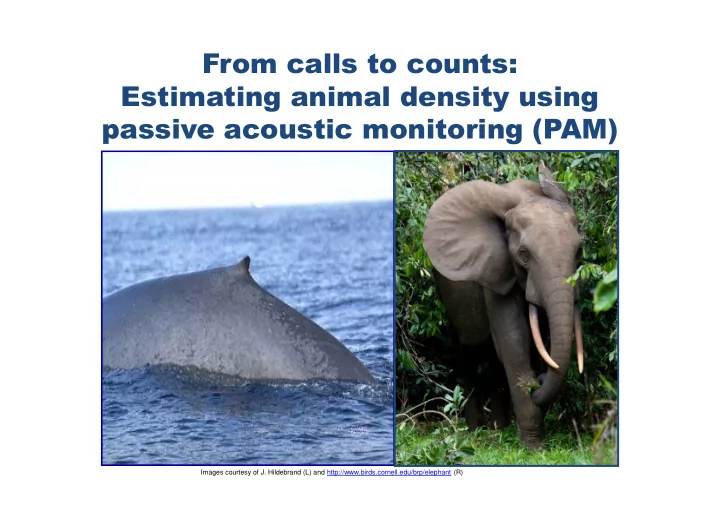

From calls to counts: Estimating animal density using passive acoustic monitoring (PAM) Images courtesy of J. Hildebrand (L) and http://www.birds.cornell.edu/brp/elephant (R)
Why acoustics?
A wealth of recorded information
Acoustic density/abundance estimation From recordings of calls… …to detecting target signal…
Acoustic density/abundance estimation …to density or abundance …to numbers of detections… number of animals in a given area • Consider missed detections • Estimate the surveyed area • Consider false detections • Consider vocal behaviour
Fixed acoustic monitoring points 50 40 30 20 10 Image courtesy of FreeDigitalPhotos.net 0 0 20 40 60 80 100 Counting animals ˆ D = estimated density n n = number of detections ˆ D w = radius of points ˆ πw 2 k P k = number of points ˆ = proportion of animals detected P
Fixed acoustic monitoring points 50 40 30 20 10 Image courtesy of FreeDigitalPhotos.net 0 0 20 40 60 80 100 Counting calls, not animals Counting animals n n ˆ ˆ D D ˆ ˆ ˆ πw πw 2 2 k P T r k P ˆ r T = monitoring time = cue rate
Detecting sounds, not individual animals A simplified example: 125 detections in a 1 hour survey ( t = 1). = 0.2. (probability of detecting a whale call) = 0.4. = 5 calls per hour. ࢉࢇ࢙ ࢉࢇ࢙ ࢇࢇ࢙ Need vocalisation production rate e.g., estimated call production rate , . If using an automatic detector - need an estimate of false positive proportion , . False negatives (in general) are taken care of by Can incorporate uncertainty/variance of any parameter into the estimator
Density estimation methods • Suite of methods available to estimate detection probability • Require different spatial information (NB: survey design) • Pros and cons to each method • Not just relevant for density/abundance e.g., how far out was my hydrophone/microphone monitoring? 3D localisation 2D Ranges localisation Bearings Detections on a single hydrophone
Density estimation methods Non standard methods Auxiliary data/more assumptions 3D localization 2D Ranges localization Bearings Detections on a single hydrophone Standard methods Distance sampling/spatial capture recapture
Can apply to many species… Image taken from: Van Ngoc Thinh et al (2010 ) Image courtesy of Phil_Bird at Image taken from: Measey et al (2016) FreeDigital Photos.net
So many instruments… http://nearest.bo.ismar.cnr.it/
So many instruments… Courtesy of http://www.afsc.noaa.gov
Points instead of transect lines… From: http://nearest.bo.ismar.cnr.it/
Points instead of transect lines…
Points instead of transect lines… NB: Preliminary results
Exploring new technologies Improved spatio-temporal coverage. Better spatial coverages than fixed sensors. Better temporal coverage than towed acoustic arrays. But slow moving – how do these instruments fit with our existing methods?
Considering behaviour • It is VITAL to understand the vocal behaviour of the study species. • Which vocalisation is best to monitor? • What proportion of the population make that sound? • What is the production rate of the vocalisation? • Does the rate show spatial and temporal variation?
In conclusion… • Increasing amount of acoustic data available worldwide. • Both from dedicated surveys and opportunistic datasets. • Density/abundance estimation using acoustics is possible. • A suite of statistical methods are available. • For planned surveys – ideally use standard methods. • For data already collected, a non-standard analysis may be possible. • Large limitation is current lack of information about acoustic behaviour of many species. Call rate is a prime example .
Key references • Marques, T.A., L. Thomas, S. Martin, D. Mellinger, J. Ward, D. Moretti, D. Harris and P. Tyack. (2013). Estimating animal population density using passive acoustics. Biological Reviews 88: 287-309 • Stevenson, B.C., Borchers, D.L., Altwegg, R., Swift, R.J., Gillespie, D.M., and Measey, G.J. (2015) A general framework for animal density estimation from acoustic detections across a fixed microphone array. Methods in Ecology and Evolution , 6 38-48. • Requested seismometer reference: Harris, D., L. Matias, L. Thomas, J. Harwood & W. Geissler. 2013. Applying distance sampling to fin whale calls recorded by single seismic instruments in the northeast Atlantic. The Journal of the Acoustical Society of America 134: 3522-3535.
Considering behaviour • It is VITAL to understand the vocal behaviour of the study species. http://cetus.ucsd.edu/voicesinthesea_org/species/pinnipeds/weddellSeal.html
Recommend
More recommend